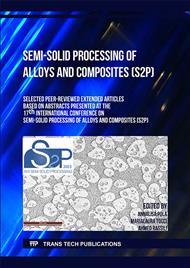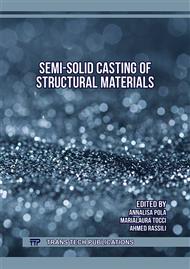p.141
p.147
p.157
p.165
p.171
p.177
p.183
p.191
p.197
CALPHAD Optimization of the Composition of EN AC-46000 Secondary Alloys for Semi-Solid Casting Processes
Abstract:
In semi-solid metal casting processes a slurry, obtained operating in the temperature window between the liquidus and the solidus curve of the phase diagram of the alloy (32.7 °C for AlSi8, 11.3 °C for AlSi11), is injected into the mould. Since the control over the process parameters becomes more complicated as the involved quantities increase, to apply these processes on an industrial scale it is necessary to widen as much as possible this narrow temperature window. This goal can be obtained by tailoring the concentration of elements constituting the alloy. A EN AC-46000 secondary alloy was selected for this study, because of its wide use in foundries. Using a CALPHAD approach, various Al-Si-based pseudo-binary phase diagrams containing main constituents of the alloy (Cu, Zn, Fe, Mg, Mn, Ni, Cr and Ti) were studied, keeping the Si content fixed from 8 to 11 wt.% and the Al content as a complement. The composition limits of acceptability of the commercial alloy EN AC-46000 were used as extremes of the simulation field. The study was then proceeded investigating the pseudo-ternary diagrams, keeping silicon and a second element fixed and a third element variable for all possible combinations. Further constituent elements of the alloy were progressively added, considering all main constituents of the alloy, and evaluating how the concentration of these elements can extend the temperature window. Mg, Fe, Mn and Ti are the most promising candidates for achieving this goal. The results of this study can provide foundries with a prediction tool to define more restrictive ranges of acceptability than those of the commercial alloy, allowing them to estimate through a simple chemical analysis whether scrap of variable composition entering the plant are suitable for the SSM process or they need preliminary corrections of composition.
Info:
Periodical:
Pages:
171-176
Citation:
Online since:
August 2023
Price:
Сopyright:
© 2023 Trans Tech Publications Ltd. All Rights Reserved
Share:
Citation:



